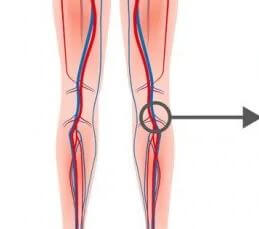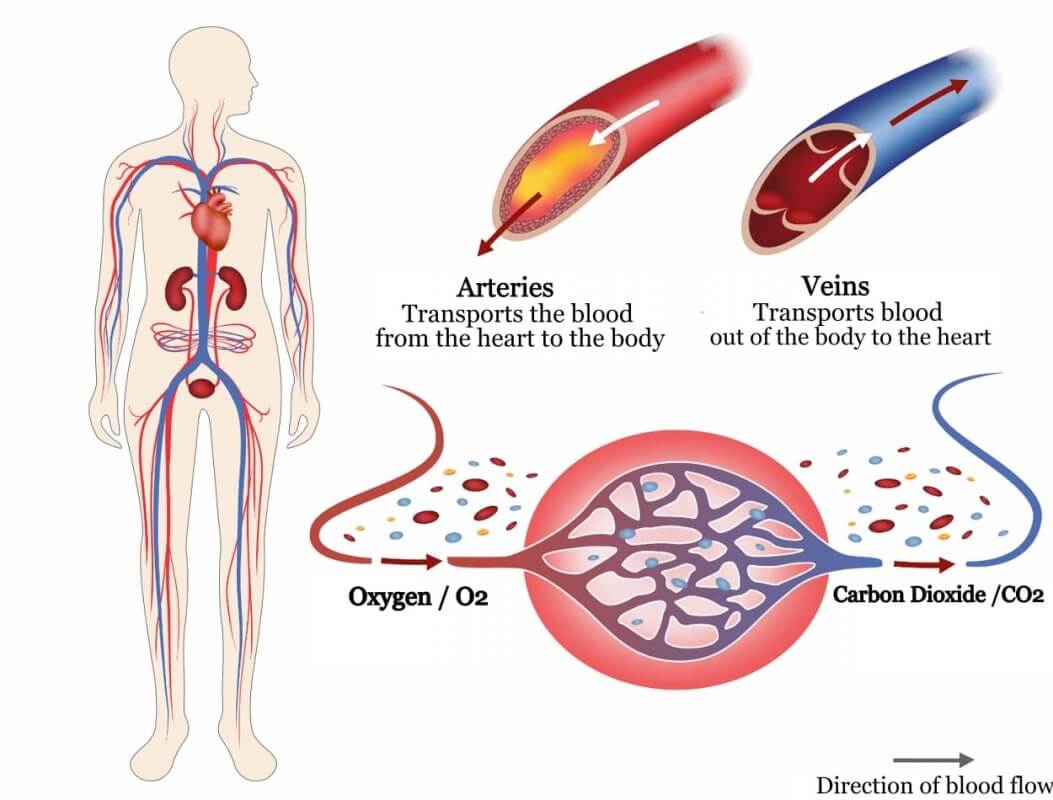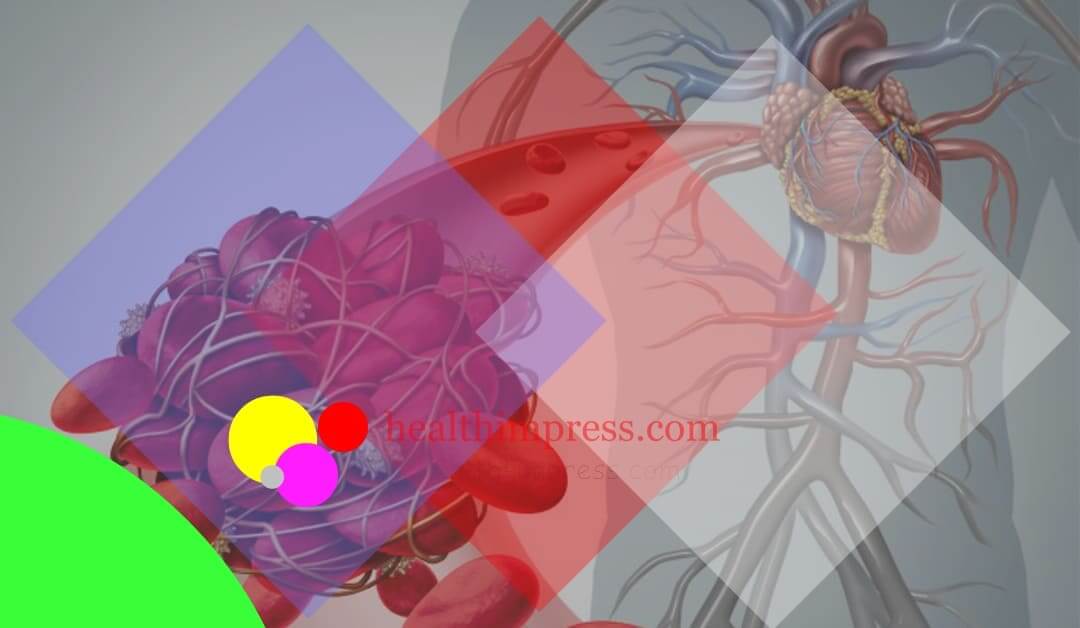General Health
What is Thrombosis, its Causes & Types?
Our focus in this research article would be focused on the introduction, definition, and types of thrombosis, which I have titled “what is thrombosis”. Doctors refer to the term thrombosis as the complete or partial occlusion (blockage) of a blood vessel by a blood clot (thrombus). If this happens in a carotid artery, it is called arterial thrombosis. If, on the other hand, a thrombus forms in a vein, it is a venous thrombosis.
The fact that our blood coagulates (change to a solid or semi-solid state), is part of our body’s vital protective mechanism. What is of the utmost importance in the case of injuries and inflammation in order to prevent excessive blood loss can, however, cause massive problems in the blood vessels, because if a blood clot forms in an artery or vein, the blood flow is disturbed. The vital blood supply to the body is therefore at risk from thrombosis.
Origin – what is thrombosis?
The word “thrombus” comes from Greek and translates as a plug or lump. The medical term thrombus is less common than the term blood clot. Thrombi occur when the blood coagulates and the platelets form a clot (thrombus). Blood clots in veins or arteries disrupt the blood flow and trigger thrombosis.
Types of Thrombosis: Vein Thrombosis & Arterial Thrombosis

A thrombus (blood clot) can form in any blood vessel. It is the blood platelets, the thrombocytes, that attach themselves to the vessel wall and clump together. As a result, a blood clot forms which obstructs blood flow.
Thrombosis is basically determined by where the thrombus is located in the body. Depending on the blood vessel in which the thrombus forms, doctors differentiate between the following two types of thrombosis:
- Arterial thrombosis, and
- Venous thrombosis
Detailed Types of thrombosis
To understand the topic what is thrombosis, the following table gives an overview of the two types of thrombosis and their usual places of origin:
| Designation | Place of origin |
|---|---|
| Type of Thrombosis | Part of the body |
| Arterial thrombosis (Arteriothrombosis) | Arteries in the: – Heart – Leg |
| Venous thrombosis | Veins in the: – Brain – Arm and shoulder girdles – Leg – Pelvis – Portal vein – Anus |
Arterial thrombosis
In an arterial thrombosis, a blood clot forms in an artery. Arteries are vessels that carry blood away from the heart to the organs. Most arterial thromboses develop where the vessels branch or become narrower, such as in the legs or in the brain. In the worst case, arterial thrombosis leads to a heart attack or stroke.
Coronary thrombosis: thrombus in the heart
If a blood clot forms in a heart vessel, it is called coronary thrombosis. Cardiac thrombosis belongs to the group of arterial thromboses. Due to the narrowed blood vessels, hardly any oxygen reaches the heart so that in the worst case, a heart attack follows.

Venous thrombosis
Venous thrombosis is when a blood clot forms in a vein. Veins are vessels that carry blood from organs and muscles back to the heart. The vascular occlusion usually occurs in the leg and pelvic veins.
Vascular occlusion is a blockage of a blood vessel, usually with a clot. It differs from thrombosis in that it can be used to describe any form of blockage, not just one formed by a clot.
Wikipedia
Thromboses in the veins can be further subdivided:
- Deep vein thrombosis (DVT): This is where the blood clot (thrombus) resides in a deep vein. The leg veins in the upper or lower leg are often affected. Typical symptoms of deep vein thrombosis are sudden swelling of the leg, pain, and bluish (if you’re light-skinned, and darkened if dark-skinned), shiny skin. Doctors speak of as phlebothrombosis.
- Superficial vein thrombosis (SVT): Here an inflammation of the vein (phlebitis) is accompanied by a blood clot in the affected, superficial vein. SVT usually occurs in the leg or as an arm thrombosis. Typical symptoms are a tight feeling on the skin on the arm or leg or an initially inconspicuous varicose vein. The medical term is thrombophlebitis.
While superficial vein thrombosis occurs less often, deep vein thrombosis is one of the most common diseases of the cardiovascular system, according to the German Society for Phlebology. In Germany, for example, around one in 1000 adults falls ill with a deep vein thrombosis for the first time every year.
Form of Venous thrombosis
Overall, venous thromboses are very diverse and are primarily differentiated on the basis of their place of origin.
Multi-level thrombosis
Usually, blood clots form in the (deep) leg veins. If the thrombus is not recognized in time, the thrombosis may expand and the blood will also begin to accumulate in the smaller secondary vessels. Eventually, there are further occlusions in the lower legs, knees, and thighs. In this case, medical professionals speak of a 3-tier thrombosis.
In acute cases, the multi-tier thrombosis spreads into the pelvis (pelvic vein thrombosis). In this case, it is a 4-tier thrombosis.
Travel thrombosis
Sitting for long periods, for example in a narrow plane (airplane), can slow the blood flow in the leg veins.
Little liquid and low humidity also reduce the blood flow speed. The blood collects in the lower legs. This can cause a blood clot to form and cause thrombosis. Those affected then suffer from the so-called “travel thrombosis”.
Anal thrombosis, anal vein thrombosis, perianal thrombosis
If the anus has thrombosis, a blood clot blocks a vein in or around the edge of the anus. This form of thrombosis is usually triggered by thermal influences such as sitting on cold surfaces or humid weather. In addition to pain in the affected area, a colored lump under the hat on the edge of the anus indicates perianal thrombosis. In many cases, the anal thrombosis resolves within days or a few weeks.
Thrombosis in the abdomen (portal vein thrombosis)
The portal vein is the blood vessel that supplies the liver with blood from the intestines. If the portal vein is blocked or narrowed by a blood clot, the blood pressure in the vein increases. Thrombosis in the abdomen can lead to an enlarged spleen, heavy bleeding in the esophagus, or a build-up of fluid in the abdomen.
Thrombosis in the head (cerebral vein thrombosis)
Cerebral vein thrombosis is a special and rare form of thrombosis. Blood with poor oxygen is transported from the brain to the heart via large venous blood vessels. If a blood clot causes the vessels to be blocked, the flow is disturbed. If the thrombus in the head is not resolved in time, the pressure in the brain increases.
Cerebral vein thrombosis is primarily characterized by yeasty headaches. Usually, the pain becomes more intense over time and can also take the form of a thunderbolt headache. Accompanying symptoms of a cerebral vein thrombosis are, for example, nausea, epileptic seizures, or neurological deficits such as speech disorders or paralysis. Possible causes of cerebral vein thrombosis include infections and bleeding disorders.
Causes of thrombosis (formation of a thrombus)
There can be different causes for a thrombus to develop in one of the blood vessels. On the whole, three different causes for the development of thrombosis can be identified:
- Impaired blood flow: The blood cannot flow freely through the blood vessels because the blood vessel walls are damaged or have deposits, or because they are constricted from the outside, for example by tumors or scarring.
- Slowed blood flow: The blood flows more slowly because the veins are dilated (varicose veins) or because the support from the muscles (muscle pump) is insufficient, for example after operations, in the event of paralysis, long immobility or lack of fluid – the blood becomes “thicker”.
- Increased tendency to coagulate: The blood coagulates faster than normal because blood coagulation is impaired (i.e. increased), for example due to genetic coagulation disorders, autoimmune or cancer diseases.
To coagulate means to change from liquid to a more solid-state, or to cause something to do this
Cambridge Dictionary
It should be noted that the location of the thrombosis also plays a decisive role here. Depending on whether it is an arterial or venous thrombosis, different factors can disrupt the blood flow:
| Forms of Thrombosis | Causative factors for impaired blood flow |
|---|---|
| Arterial thrombosis | – Changes in the arteries, for example in arteriosclerosis |
| Venous Thrombosis | – Major (orthopedic) operations – Phlebitis – Varicose veins – Dehydration – Cancer |
What is meant by arteriosclerosis?
Atherosclerosis is also often referred to as vascular calcification. This means a change in the vessel walls of arteries. Blood components such as calcium, fat or connective tissue can accumulate in the vessel walls and constrict the affected artery. This disrupts the flow of blood in the vessel, so that a thrombus or several thrombi can form.
Conclusion to introduction, definition, and types of Thrombosis
From the above, we have given a detailed introduction, definition, and types of Thrombosis ( what is thrombosis). Going forward, our hope is that you now totally understand what thrombosis is and are now equipped to deal with it before it rears its ugly head. In the coming days, I will be sharing other bits about thromboses such as their risk factors, symptoms, diagnosis, and many more.
Take care!
Sources:


